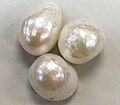Файл:Pearls 2.jpg

Исходный файл (2705 × 2359 пкс, размер файла: 1,82 МБ, MIME-тип: image/jpeg)
Этот файл находится на Викискладе. Сведения о нём показаны ниже.
Викисклад — централизованное хранилище для свободных файлов, используемых в проектах Викимедиа.
Сообщить об ошибке с файлом |
Краткое описание
| ОписаниеPearls 2.jpg |
English: (the pearl at right is ~1.4 centimeters across at its widest)
(photo by Tyler Houck) Pearls are spherical to subspherical to irregularly-shaped, biogenic concretions of slightly iridescent, nacreous aragonite (CaCO3 - calcium carbonate). Pearls are principally made by pearl oysters (Animalia, Mollusca, Bivalvia). Natural pearls are scarce. Well-formed, spherical natural pearls are rare. Fossil pearls are known, but are also scarce. "Mother of pearl" is relatively common - the same material in pearls occurs in the actual shells of some bivalves. Well-known pearl oysters include Pinctada margaritifera (the black-lipped pearl oyster), Pinctada fucata (the Japanese pearl oyster), and Pinctada maxima (the gold-lipped pearl oyster). Mother-of-pearl is well developed in shells of other species such as Pinctada imbricata (Atlantic pearl oyster), Pteria colymbus, Pteria penguin (both are winged pearl oysters), Haliotis spp. (abalones), and Atrina spp. (pen shells). Natural pearls form when foreign objects, such as sediment grains or other debris, enter a pearl oyster and get embedded in its mantle tissue. The particle is slowly coated with nacreous aragonite, which prevents the particle from causing disease or injury. The end result is a biogenic concretion called a pearl. Natural pearls show a concentric structure through the entire cross-section. Almost all commercially available pearls are semi-natural - they have been cultured. Cultured pearls have been available for many decades. A spherical bead is placed inside a pearl oyster, under its mantle tissue. The bead is slowly coated with nacreous aragonite to produce a cultured pearl, which shows concentric structure only in the outer portions of its cross-section. Marine pearls can be whitish, pinkish, yellowish, or blackish. Freshwater pearls are also known - natural examples vary from ~spherical to highly irregularly-shaped. Blister pearls are attached to the host mollusc's shell. See info. at: en.wikipedia.org/wiki/Pearl |
| Дата | |
| Источник | https://www.flickr.com/photos/47445767@N05/49554801623/ |
| Автор | James St. John |
Лицензирование
- Вы можете свободно:
- делиться произведением – копировать, распространять и передавать данное произведение
- создавать производные – переделывать данное произведение
- При соблюдении следующих условий:
- атрибуция – Вы должны указать авторство, предоставить ссылку на лицензию и указать, внёс ли автор какие-либо изменения. Это можно сделать любым разумным способом, но не создавая впечатление, что лицензиат поддерживает вас или использование вами данного произведения.
| Это изображение изначально опубликовано на Flickr участником проекта James St. John по ссылке https://flickr.com/photos/47445767@N05/49554801623. Оно было досмотрено 20 февраля 2020 роботом FlickreviewR 2, который подтвердил, что изображение лицензировано в соответствии с условиями cc-by-2.0. |
20 февраля 2020
Краткие подписи
Элементы, изображённые на этом файле
изображённый объект
12 февраля 2020
0,025 секунда
4,15 миллиметр
История файла
Нажмите на дату/время, чтобы посмотреть файл, который был загружен в тот момент.
| Дата/время | Миниатюра | Размеры | Участник | Примечание | |
|---|---|---|---|---|---|
| текущий | 19:23, 20 февраля 2020 |  | 2705 × 2359 (1,82 МБ) | Ser Amantio di Nicolao | User created page with UploadWizard |
Использование файла
Нет страниц, использующих этот файл.
Глобальное использование файла
Данный файл используется в следующих вики:
- Использование в en.wikipedia.org
- Использование в no.wikipedia.org
Метаданные
Файл содержит дополнительные данные, обычно добавляемые цифровыми камерами или сканерами. Если файл после создания редактировался, то некоторые параметры могут не соответствовать текущему изображению.
| Производитель камеры | Apple |
|---|---|
| Модель камеры | iPhone SE |
| Время экспозиции | 1/40 с (0,025) |
| Число диафрагмы | f/2,2 |
| Светочувствительность ISO | 25 |
| Оригинальные дата и время | 17:51, 12 февраля 2020 |
| Фокусное расстояние | 4,15 мм |
| Ширина | 3024 пикс. |
| Высота | 4032 пикс. |
| Глубина цвета |
|
| Цветовая модель | RGB |
| Ориентация кадра | Нормальная |
| Количество цветовых компонентов | 3 |
| Горизонтальное разрешение | 72 точек на дюйм |
| Вертикальное разрешение | 72 точек на дюйм |
| Программное обеспечение | Adobe Photoshop Elements 16.0 (Macintosh) |
| Дата и время изменения файла | 23:26, 18 февраля 2020 |
| Порядок размещения компонент Y и C | Центрированный |
| Программа экспозиции | Программный режим (нормальный) |
| Версия Exif | 2.21 |
| Дата и время оцифровки | 17:51, 12 февраля 2020 |
| Конфигурация цветовых компонентов |
|
| Выдержка в APEX | 5,322390019698 |
| Диафрагма в APEX | 2,2750071245369 |
| Яркость в APEX | 5,2328854766475 |
| Компенсация экспозиции | 0 |
| Режим замера экспозиции | Точечный |
| Статус вспышки | Вспышка не срабатывала, подавление заполняющей вспышки |
| Доли секунд оригинального времени | 103 |
| Доли секунд времени оцифровки | 103 |
| Поддерживаемая версия FlashPix | 1 |
| Цветовое пространство | sRGB |
| Тип сенсора | Однокристальный матричный цветной сенсор |
| Тип сцены | Изображение сфотографировано напрямую |
| Режим выбора экспозиции | Автоматическая экспозиция |
| Баланс белого | Автоматический баланс белого |
| Коэффициент цифрового увеличения (цифровой зум) | 1,7581395348837 |
| Эквивалентное фокусное расстояние (для 35 мм плёнки) | 51 мм |
| Тип сцены при съёмке | Стандартный |
| Использованный объектив | iPhone SE back camera 4.15mm f/2.2 |
| Дата последнего изменения метаданных | 18:26, 18 февраля 2020 |
| Уникальный идентификатор исходного документа | CF33FE4C4C1FB4C4E1068A871C18DA74 |